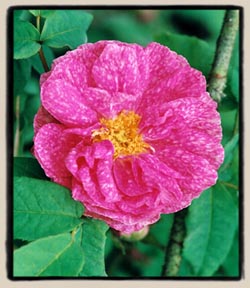 |
|
Albas |
Welcome to the November edition of my web site. The roses I write about are the Old Garden Roses and select shrub and miniature roses of the 20th century. For tips on rose culture, pruning, propagation and history, see "Other resources on this site". To return to this page, click on the "thorn icon" in the margin at left. Articles from the previous months are archived and can be viewed by clicking on the listings in the left margin. Oh, and please don't write to me for a catalog or pricelist.....this is an information site only.....not a commercial nursery. If you wish to buy roses, see my sponsor, The Uncommon Rose. Thanks! Hybridizing
with the Gallicas
At left: 'La Belle Sultane' Rosa gallica, the species from which hundreds of hybrids evolved, is thought to be native to France, Turkey, Iraq and possibly Belgium. In recent times, Martyn Rix went to search for R. gallica in the Alpes-Maritimes region of France where he found blooming plants near the village of Sigale. The roses described in Pliny's Natural History circa 79 A.D. may have been R. gallica, placing this rose in Roman cultivation at a very early date. The early hybrids, such as 'Apothecary's Rose', became distributed throughout Europe in the centuries that followed, used ostensibly for culinary and medicinal purposes. While its precise origins are not known, 'Apothecary's Rose', or R. gallica officinalis is believed to have existed before 1400, and the striped sport, 'Rosa Mundi', is thought to have existed since 1581. English documents dating to the fourteenth century suggest that the Gallicas may have arrived in England as early as 1200 A.D. In the 1700's, Rosa gallica earned its French pseudonym, 'Rose of Provins', as it was grown commercially for perfumes and medicines in the region of Provins during that time.
At right: 'Tuscany' The French did the most intensive work with Gallicas, from the early 1800's through the 1890's, with the most intensive period of Gallica breeding being from 1820 to 1860. Interestingly, most of the hybrids produced during this period were the result of random pollination. The mechanics of pollination were not fully understood until late in the 1800's, when manual cross-pollination was employed, resulting in an increase in the diversity of bloom styles. Sadly, the popularity of the Gallicas declined in the 1890’s as new varieties were developed which bloomed repeatedly through the growing season.
At left: 'James Mason' One of the most clever and experimental hybridizers of the 20th century was E. B. LeGrice of England, who used some of the Gallicas to develop unusual colors in his roses. It was his intention not to create new Gallicas, but to infuse their pigments into his Floribundas and other repeat blooming hybrids. Two cultivars that are known to have contributed to this work are 'Marcel Bourgoin' and 'Tuscany Superb', both deep purples. In fact, records show that 'Tuscany Superb' is supposed to have been the pollen parent of the 1968 Floribunda, 'News'. (This suggests that it is sometimes possible to breed repeat blooming roses from the Gallicas. LeGrice documented several instances of this in his career. Later, David Austin discovered the same phenomenon when using 'Duchesse de Montebello' in his work.) LeGrice credits these Gallicas as having contributed significantly to the search for purple in his work.
David Austin's wildly successful English Roses began nearly 40 years ago with two Gallica hybrids: the deep crimson-purple 'Tuscany', and the blush pink 'Belle Isis'. In 1961 Austin crossed Edward LeGrice's Floribunda, 'Dainty Maid' with 'Belle Isis' to create the famous 'Constance Spry', a cornerstone of his pink English Roses. In a similar cross from 1967, 'Dusky Maiden' (also a LeGrice Floribunda) was crossed with 'Tuscany', resulting in 'Chianti', a wine-purple hybrid that started the crimson English Roses. In one of his books, Austin stated that although he himself has chosen not to pursue the further breeding of Gallicas, for some adventurous individual it would be a perfectly worthwhile goal. That idea stuck in my mind ever since, and now I am working on breeding new Gallicas, using both old and more modern hybrids. Four years of working with the Gallicas has already taught me quite a bit about how they interact genetically with other roses. Early in this project, I chose 'Tuscany Superb' as one of the seed parents to explore because of its wonderful color and its fine growth habit. This choice has proven to be a good one, as 'Tuscany Superb' is a willing seed and pollen parent, producing seed that germinates readily. Depending on the other parent, many of its seedlings have excellent disease resistant. In fact, I find many of its offspring to have better mildew resistance than crosses made using modern parents.
Some early crosses were made with roses I had on hand to work with, and so some very odd hybrids resulted. One of the earliest was a cross of 'Tuscany Superb' by the miniature 'Black Jade'. It took two years to see the first blooms; some were interesting, and some were downright awful! One produced nearly black blooms about 2" across on a climbing plant with miniature leaves, but the blooms burned very easily in sunlight. Two others had attractive blooms and have been retained for further breeding. One has a large, very double, deep pink bloom on a five-foot shrub that has been completely disease free, so far. This one sets seed easily, and has produced seed by many diverse parents this year, including ‘Fairy Moss’ and ‘Buff Beauty’. The other has myrrh scented blooms that look a lot like 'Constance Spry' on a typical Gallica shrub. I have noticed that the myrrh fragrance comes up often when crossing 'Tuscany Superb' with modern repeat-blooming roses.
Another hybrid using 'Tuscany Superb' and Austin's 'Othello' produced several very attractive shrubs, many of which have the wonderful myrrh scent. One of these seedlings is a three-foot shrub of graceful arching form and medium pink, fully double blooms. It produces blooms in amazing quantities, and has been completely disease free. While this is a very attractive rose in its own right, I think of it more as an intermediate step towards other goals. Another seedling from the same cross inherited a bit more of 'Tuscany Superb's rich coloring, also on an arching shrub with disease-proof foliage. This one bears 4.5- to 5-inch single blooms of a deep, glowing, medium crimson hue, with a fine fragrance. The blooms are reminiscent of those of 'James Mason'. This plant is remarkably healthy, blooms well in partial shade, and sets seed with reasonable ease. Again, while it is very beautiful, it is a rose I think of as being a stepping stone to better things.
One other hybrid I made used pollen from 'Tuscany Superb' on the dark purple Moss rose, 'Nuits de Young'. I doubt that 'Nuits de Young' has been used often to obtain mossed progeny, but it is certainly willing and able to do so! Out of about six seedlings that I kept from this cross, three of these were well mossed, and of the most glorious purple hue! The best of the three is a tall, upright shrub with very dark foliage much like its seed parent. The well-shaped, fully double blooms are the richest royal purple, and quite large for its type. There is quite a bit of mossing on the sepals. This plant has been very willing to produce seed that germinates very well. Last year I used this Moss as a seed parent with pollen from Ralph Moore's 'Scarlet Moss'; however, I won't see any of these bloom until next year. 'Scarlet Moss' has the ability to pass on rebloom, compact shrub size, and rich coloring. I plan on crossing the best of these seedlings with each other in the hopes that I will obtain a percentage of seedlings that repeat and have the dark purple coloring.
In the past two years I have collected many more Gallicas, with the intention of using several of them in breeding. I have bred 'Belle Isis' this year, as well as 'Duchesse de Montebello', 'La Belle Sultane', 'James Mason', and 'Alain Blanchard'. I am very interested in expanding the number of dramatically spotted hybrids, and so 'Alain Blanchard' figures strongly in my plans. I am also working with the Damask Perpetual 'Marbreé', which produces many spotted offspring, some of which are repeat bloomers. I currently have seedlings of this sort approaching blooming size.
Eventually I would like to create some Portland type shrubs with the same rich colors and forms of the Gallicas, from intensely double to perfect singles. ‘Rose de Rescht’ shows promise as a useful parent towards this goal. I also have some seedlings from crosses using ‘La Belle Sultane’ as a seed parent, which I expect will result in some singles. I am also incorporating 'Chapeau de Napoleon' in my work to breed new Crested Hybrids. (I am indebted to Mr. Ralph Moore and his manager, Carolyn for assisting me in my pursuit of this goal.) Next year I hope to see the first blooms on some seedlings from the cross of 'Tuscany Superb' x 'Chapeau de Napoleon'. I am imagining big single blooms of the richest purple, with crested sepals! Can you picture it?! * The Heritage Roses Group, formed in 1975, is a fellowship of those who care about Old Roses. To join the group and receive the quarterly bulletin, send $6.00 to The Heritage Roses Group, C/O Helen Pressley, P.O. Box 7606, Olympia WA 98507
Original photographs and site content © Paul Barden 1996-2003 |
|

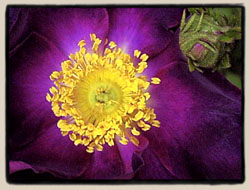 To
me, the Gallicas are some of the most beautiful roses ever created.
Extraordinary forms and colors are found in this class, from the deepest
purples to soft pinks and near-whites, with a few spotted, striped,
and mottled varieties. They offer a richness and sophistication with
which few modern roses can compare. That is why I decided, several years
ago, to begin breeding new Gallica hybrids.
To
me, the Gallicas are some of the most beautiful roses ever created.
Extraordinary forms and colors are found in this class, from the deepest
purples to soft pinks and near-whites, with a few spotted, striped,
and mottled varieties. They offer a richness and sophistication with
which few modern roses can compare. That is why I decided, several years
ago, to begin breeding new Gallica hybrids. 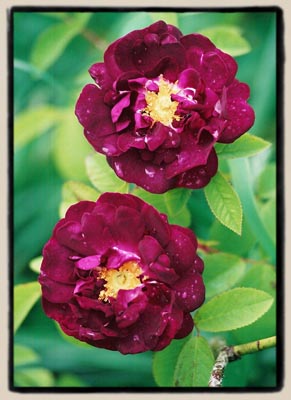 The
Dutch were growing vast numbers of Gallicas from seed in the mid to
late 1600's. It is thought that the variety '
The
Dutch were growing vast numbers of Gallicas from seed in the mid to
late 1600's. It is thought that the variety ' Contemporary
work using Gallicas for breeding purposes includes Peter Beales' 1982
cultivar, '
Contemporary
work using Gallicas for breeding purposes includes Peter Beales' 1982
cultivar, '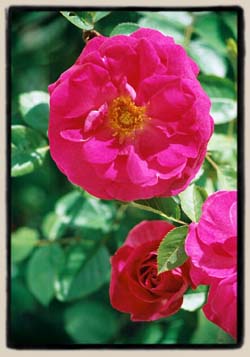 At
right: A seedling from the
cross of 'Tuscany Superb' X 'Black Jade'.
At
right: A seedling from the
cross of 'Tuscany Superb' X 'Black Jade'. 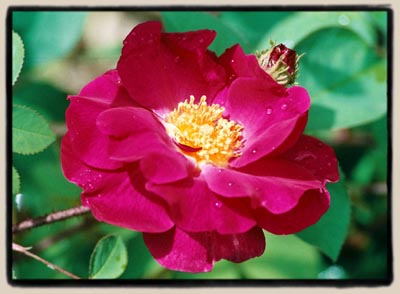
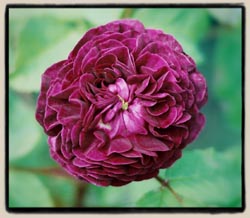 At
right:
At
right: 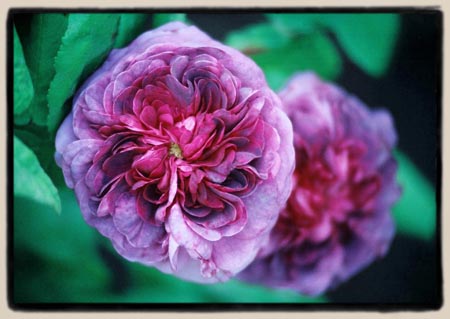
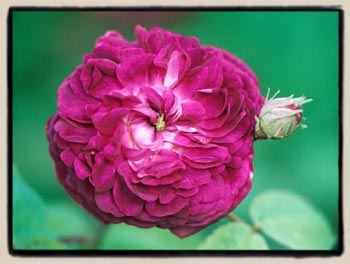 At
right: a Gallica grown from
open pollinated seed.
At
right: a Gallica grown from
open pollinated seed.